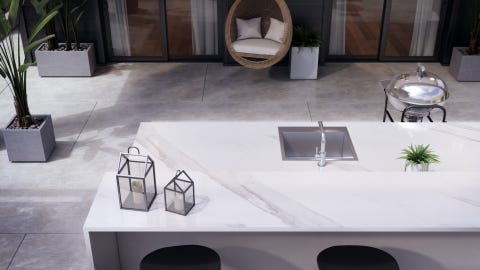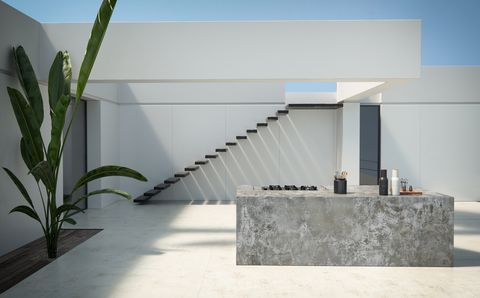The pandemic-induced craze for outdoor living is here to stay. A 2021 survey found that 82 percent of homeowners are more interested in investing in outdoor rooms than they were prior to the pandemic. Once considered a nice-to-have amenity, space to gather and cook outside has become a priority for many.
But there’s more to creating an outdoor kitchen than just buying a grill and a set of patio furniture. Materials matter in this space even more than they do indoors, as they need to withstand the sun, rain, wind, and anything else that might come your way. Here’s everything you need to consider when designing an outdoor kitchen, from lighting and seating to appliances and countertops.
1. Protection from the elements
The best outdoor kitchens are those that can be used nearly year-round, not just when the weather cooperates. An absolute necessity—no matter your climate—is an overhead covering like a pergola or awning that will keep the sun’s rays at bay as well as add a layer of protection when it rains.
From there, consider add-ons that address specific needs. If wind is a problem, add screens or make a barrier with tall bushes. If temps are cooler, opt for wall-mounted or umbrella heaters. Ceiling fans can do double-duty, providing extra heat relief and keeping mosquitoes at bay.
2. The right materials
Durable materials are crucial for an outdoor kitchen, which will be subjected not just to the normal wear and tear of a high-trafficked space but also the whims of Mother Nature. Choose materials that can handle temperature fluctuations without warping or cracking.
Dekton from Cosentino is a composite surface made of minerals and raw materials that’s virtually indestructible, which makes it the ideal material for countertops and flooring in an outdoor space. It can withstand extreme temperatures and exposure to UV rays without fading, it’s highly scratch- and impact-resistant (you can chop right on the surface), and the nonporous design makes it easy to clean and maintain.
It’s also a carbon-neutral line that uses a manufacturing process powered by 100-percent renewable energy sources, and all water used in production processes is treated and reused to eliminate waste. Plus, a few of its 50-plus styles, such as the oxidized steel–inspired Trillium, are made with up to 80 percent recycled materials.
3. Balanced lighting
Without proper lighting, an outdoor kitchen is rendered useless when the sun goes down. So you’ll need to add task lighting above prep and cooking zones.
Avoid harsh spotlights when it comes to illuminating the entire space and instead opt for landscape lighting embedded in the floor or dimmable lights that can be hung on a pergola roof or awning. Candles on the table are always a nice touch. Another option: solar-powered tea lights that automatically turn on when it gets dark.
4. Appropriate appliances
With hundreds of fancy pizza ovens, smokers, and grills on the market, it’s easy to be overwhelmed when it comes to choosing appliances for your outdoor kitchen. But consider how you cook and what will be most useful: If you’ve never whipped up a Margherita pie inside, are you really going to use a $1,000 wood-burning pizza oven outside?
On the flip side, if you always serve a signature cocktail while you’re cooking, make room for a mini-refrigerator and ice-maker. If you want space to boil shrimp and grill a dozen burgers at the same time, you’ll need an ample amount of burners.
5. A functional layout
The space in which you’re working will dictate the layout of an outdoor kitchen. L-shaped kitchens with a bar are great for larger patios where you plan to entertain frequently, but a simple run of one or two cabinets with a grill can be just as functional in a smaller space.
Plan appropriately for utilities like gas, electricity, and water. A typical kitchen has four zones: hot for cooking, dry for prep, wet for the sink, and cold for refrigeration and ice. But if space is limited, you can forgo the latter two by situating your outdoor cooking space in close proximity to your indoor kitchen in order to utilize its refrigerator and sink.
6. Plenty of seating
The point of an outdoor kitchen is to entertain, so make sure your guests have somewhere to sit. A sturdy dining table, big enough to hold your delicious grilled spread and a hungry crowd, is a must.
Consider a custom piece designed specifically for your space with a Dekton top; the same reasons it’s top-notch for counters and floors make it great for a busy table. And it comes in styles that mimic the look of marble, concrete, wood, and various types of stone.
If space allows, carve out a more relaxed nook with a couple of plush armchairs or loungers that you can use for morning coffee or after-dinner cocktails.
This content is created and maintained by a third party, and imported onto this page to help users provide their email addresses. You may be able to find more information about this and similar content at piano.io




